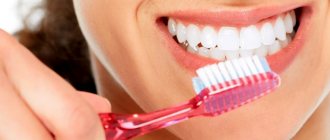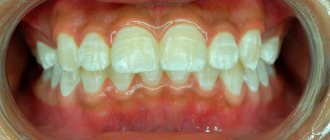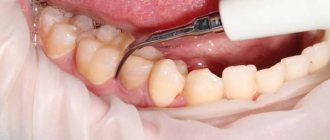Author of the article: Ovchinnikov Alexander Vasilievich
Specialization: Dentist-therapist
Total work experience: since 2001
The diagnosis of “wedge-shaped dental defect” is associated in most patients with a wedge-shaped depression at the base of the tooth. But not every cervical defect is wedge-shaped. Moreover, the disease refers to non-carious lesions that require a special approach to treatment. In the “Smile Factor”, the doctor will identify the prerequisites for the formation of such defects, and if the integrity of the dental tissues is already compromised, he will conduct a thorough diagnostic search and restore the tooth using modern techniques.
Wedge-shaped defect - what is it?
This term refers to the loss of dental tissue in the cervical region, and the defect resembles a triangle (wedge) in shape.
A wedge-shaped dental defect differs from ordinary caries not only in external signs, but also in the characteristics of its occurrence and course. A V-shaped lesion of hard tissues is detected precisely in the area of the tooth neck - the most vulnerable place from an anatomical point of view. As the wedge-shaped defect increases in the periodontium, destructive phenomena develop, against the background of which tissue atrophy and gradual lowering of the marginal gum occur.
Causes of pathology
Due to their occurrence, there are several types of wedge-shaped defects:
- Abfraction type (from the English abfraction - microdamage). Such defects arise due to local stresses in the cervical region, which are caused by improper distribution of chewing pressure. A similar problem is often found in patients with malocclusions and people with bruxism. During the contact of the upper and lower dentition, individual teeth experience an atypical load. The cutting edge, equator zone, chewing surfaces cope with excess bending stress, and the neck area, due to its smaller thickness and mineralization, begins to collapse. The enamel gradually changes its structure, becoming weaker and losing its upper layers.
- Abrasive in nature. Tissue deficiency occurs due to their accelerated abrasion under the influence of aggressive factors. Highly abrasive pastes, very hard toothbrushes, long brushing of teeth, and folk remedies for lightening enamel at home (soda, salt) have a negative impact. Abrasives not only contribute to the destruction of vulnerable areas of the teeth, but also injure the soft tissues of the oral cavity.
- Erosive type. The main role in the formation of defects here belongs to chemical agents, especially acids, which are found in carbonated drinks, fizzy candies, fruits and berries, wine and juice. Acids interact with calcium ions, without which the enamel crystal lattice loses stability. The upper layers become porous and more susceptible to external factors. As a result, hard tissues are destroyed. Defects of an erosive nature are typical for representatives of the chemical industry who are faced with the deposition of chemical compounds in the oral cavity.
Predisposing factors for wedge-shaped defects are periodontal diseases, peptic ulcers of the stomach and duodenum, increased stomach acidity, psychoneuroses, and irregular oral hygiene.
Symptoms of a wedge-shaped defect
The disease most often affects canines and premolars. Typically, wedge-shaped defects are detected on several teeth; a single lesion is rare in clinical practice.
Aesthetic consequences
The presence of even one gap in the dentition can change the proportions of the face over time. Age-related aging processes accelerate, become more noticeable, and intensify:
- due to alveolar bone resorption, facial height decreases;
- vertical lines become more noticeable in the area of the lips and chin, making the face look rougher;
- The bite gradually changes, which can cause the proportions of the lips to be disrupted and the chin to change;
- with edentulism in the upper jaw, the nasolabial groove deepens faster and more noticeably, which is why the face looks older;
- It is possible to form a double chin if the attachment of the muscles to the body of the lower jaw is disrupted and their tone decreases.
Signs of a wedge-shaped tooth defect:
- Formation in the cervical region of a characteristic V-shaped ledge with a shiny smooth surface;
- Gradual pigmentation of the resulting defect - the affected areas acquire a yellowish-brownish color;
- It is possible to develop hyperesthesia with a pain reaction to temperature and other stimuli;
- With deep defects, hygiene procedures (cleaning, rinsing the mouth) cause pain;
- The crown part of the tooth becomes brittle; with a sharp simultaneous load, there is a high risk of tooth fracture.
When diagnosing, the doctor analyzes the location of the grooves, their shape, the shade of the teeth, and the density of the enamel. The depression with a wedge-shaped defect has a hard bottom, smooth walls and smooth edges, unlike a carious cavity.
Chipped tooth
A chipped tooth can also be a consequence of gradual destruction. The enamel cracks, part of the tooth begins to decay and a significant part of the tooth surface breaks off.
First, you need to understand that the shield of your tooth is the enamel. It is the strongest tissue in the human body and at the same time very thin and fragile. It is enough to try to bite through a strong nut or wire and you will have a problem for the rest of your life - destruction of enamel and, as a result, tooth decay. Almost always this process is accompanied by pain.
What to do if a piece of your tooth breaks off:
- Contact a dental clinic. The first day after the enamel is chipped is decisive: whether you will lose the tooth if it is severely chipped, or whether you can “fix” it.
- If possible, save a piece of chipped enamel to establish the correct diagnosis.
Cost of treating a wedge-shaped defect
| Superficial caries | 2 200 ₽ |
| Average caries | 3 800 ₽ |
| Deep caries | 4 600 ₽ |
| Relief of acute pain (anesthesia, medicinal treatment of canals, application of medications, temporary filling) | from 3,100 ₽ |
| Temporary filling | 300 ₽ |
| Treatment of cervical caries | 3 200 ₽ |
Make an appointment
Stages of the disease
There are several stages in the course of a wedge-shaped defect:
- Initial. The depression is almost impossible to see with the naked eye; damage to the enamel can only be diagnosed by a dentist.
- Superficial. The defect is revealed in the form of a superficial groove 2-3 mm long; the tooth can react to external stimuli.
- Average. The notch becomes deeper, its length increases to 4-4.5 mm, the walls of the defect are visually determined, which converge with each other in the form of the letter V.
- Deep. The wedge-shaped defect is clearly visible, the length of which is 5 mm or more. In depth, the lesion reaches the deep layers of dentin, in severe cases it reaches the pulp chamber.
The first two stages are usually diagnosed in young patients. Medium and deep degrees of damage are more typical for mature people who have crossed the 40-45 year mark.
It is noteworthy that during the course of the disease there are 2 phases - rapid and stable. In the fast phase, tissue loss occurs at a high speed (in 2-3 months), and tooth hypersensitivity develops. In the stabilization phase, the development of the disease slows down, hyperesthesia decreases or disappears altogether.
What can cause caries
There are several suggestions, for example, that tooth decay is transmitted genetically or that lack of hygiene contributes to the development of the disease. All this is true, but does not give the complete picture.
Where a person lives can also influence the occurrence of caries, namely the quality of water in that area.
Nutrition plays an important role in the prevention of caries. There are scientific studies confirming that eating fresh vegetables, greens and foods rich in proteins helps prevent tooth decay. That is, those people who like to chew raw carrots are less susceptible to dental diseases. That's why you should eat meat and a lot of raw vegetables - this is not only smart advice from nutritionists, but sound prevention in the fight against the development of dental caries.
Prices for treatment of wedge-shaped dental defects
If you start treating a wedge-shaped defect in the early stages, treatment measures will be aimed at restoring the enamel structure using conservative methods without preparation.
A pronounced depression requires more serious manipulation and restoration of the crown of the tooth using various therapeutic and orthopedic methods. The difficulty of treating deep defects is due to the small thickness of the cervical region, because there is always a risk of accidental opening of the pulp chamber. Of course, this factor affects the cost of treatment - simple remineralization therapy is cheaper than stage-by-stage tooth restoration, which requires jeweler precision from the doctor in especially severe cases.
The specifics of the disease require the use of more complex medical techniques using special instruments and high-tech materials (it will not be possible to simply fill a tooth; the filling will fall out after some time). You also need to take into account the prices for microprosthetics - installing veneers or lumineers is more expensive than restoration work.
The “Smile Factor” has introduced effective methods for treating wedge-shaped defects, and prices remain at an affordable level even for high-tech services. Regular discounts and promotions will help solve the problem without much damage to your finances - the doctor will offer the most reliable and profitable options without extra costs.
Modern methods of treatment
Damage to teeth due to a wedge-shaped defect is eliminated in several ways. The treatment plan is drawn up individually after determining the stage of the disease and the number of teeth affected.
Fluoridation of enamel
The procedure involves a course of applications with preparations based on calcium and fluoride. For the best penetration of ions into tooth tissue, electrophoresis is often prescribed. Fluoridation makes it possible to compensate for the lack of fluorides in enamel, increase its resistance to external influences, and reduce sensitivity to acids.
Remineralization
Small defects a few millimeters in size do not require filling - remineralization of enamel and dentin with special preparations (for example, enamel-sealing liquid) shows a good effect. The number of sessions is determined by the doctor; after each procedure, the enamel is covered with fluoride varnish to create a protective film.
Orthodontic treatment
In case of malocclusion, it is necessary to normalize the relationship of the dentition, which is achieved by installing a brace system or other orthodontic devices. The process can take up to 2 years, but this eliminates the root cause of the disease, chewing pressure is distributed evenly without overloading individual teeth. In some cases, the help of an orthopedist is indicated, who carries out selective grinding of some units to eliminate premature contact between the upper and lower teeth.
Installing a filling or crown
For moderate defects, filling is indicated, and before treatment it is necessary to relieve the affected tooth as much as possible in order to avoid the filling falling out. For filling, the doctor uses fluid-flowing composites, the high elasticity of which “smoothes out” the increased load and ensures a good marginal fit of the filling. Deep defects that pose a risk of tooth fracture are eliminated by installing ceramic or metal-ceramic crowns.
Veneers or Lumineers
To improve aesthetics and prevent relapses, filled teeth can be covered with veneers or lumineers. These are the thinnest ceramic veneers that are installed on the outside of the teeth. Veneers are chosen when the enamel has a “reserve” of thickness for minimal preparation. If the enamel is very thin, it is preferable to install lumineers, which do not require prior removal of a layer of tissue.
Recommendations from experts
After restoration work, a “clear” diet should be followed for several days to prevent staining of the material. When installing veneers or lumineers, you must avoid increased chewing load and do not break hard foods and objects with your teeth.
Particular attention should be paid to preventing night teeth grinding, and do not neglect wearing mouth guards prescribed by a specialist. The doctor will also select for you a suitable toothpaste with a remineralizing effect, as well as products that reduce hypersensitivity (gels, rinses with fluoride).
Tip: when using remineralizing pastes and gels, it is recommended to hold the foam in your mouth for 40-60 seconds, which will allow fluoride and calcium ions to penetrate deeper into the enamel pores.
Prognosis and prevention
The prognosis of the disease is favorable, especially if the patient sought dental care in the early stages. Complex treatment eliminates the resulting defect, restoring the aesthetics and functionality of the affected teeth.
Preventive measures to prevent a wedge-shaped defect:
- Using toothbrushes with soft bristles of uniform length;
- “Sweeping” movements when brushing teeth without pressing on the enamel;
- Limiting the consumption of carbonated drinks, sour juices;
- Protecting teeth from increased stress (gnawing seeds, nuts);
- Treatment of conditions accompanied by increased stomach acidity;
- Maintaining an optimal balance of microelements in the body.
Simple measures will help maintain the achieved treatment results and prevent the formation of new defects.
Still have questions? Make an appointment!
An accurate diagnosis with the development of a correct treatment plan is only possible in an equipped clinic, where the doctor uses all his experience to solve the patient’s problem.
“Smile Factor” invites you to come for a consultation to undergo a highly accurate diagnosis, find out all the treatment options in your case, get a predictable result - and all this at reasonable prices! We keep the cost of our services at a truly affordable level so that our patients are satisfied with all aspects of the clinic. You can make an appointment at a time convenient for you - you can make an appointment with a doctor by phone or using the online form. Waiting for you!
How does the treatment work?
Modern dental clinics can use several options to treat teeth to stop the process of tooth decay. The choice of method depends on the cause of enamel destruction. To determine the cause, you need to visit a dentist for an examination.
Sometimes your dentist may recommend that you see an immunologist to get tested. It is possible that first you need to undergo a course of treatment for a chronic disease, and only then take care of your dental health.
The easiest way is to take a vitamin complex. Perhaps the cause of tooth decay is due to a lack of microelements, and therefore a weakened immune system.
Stages of cervical caries
Cervical caries develops according to the same scenario as other types of this disease, but much faster. Let us describe the stages of development of root caries:
- Initial (white spot stage). It is asymptomatic. A demineralized area of enamel forms in or under the gum area. It looks like a white or chalky spot. Gradually it begins to fade, but this is difficult to notice with the naked eye, especially if the pathology is localized on the back surface of the tooth or on the molars and premolars. If it starts under the gum, then it can only be detected using hardware diagnostics.
- Superficial. The carious spot becomes larger and acquires a yellowish or brownish tint. Destructive processes begin on the tooth surface. At this stage, the pathological focus has not yet spread to hard tissue. The patient may experience discomfort when eating sweet foods. It disappears immediately after the stimulus is removed. Often people attribute this symptom to increased sensitivity of the gums.
- Average. Damage to hard tissues is observed. A person experiences severe discomfort when eating sweet, sour, cold or hot foods. Possible pain. These signs disappear as soon as you brush your teeth.
- Deep. The last stage is an advanced form of the disease. Deep damage to dentin occurs. The pathological process involves the tooth root and pulp. The tooth may split into several parts or break in the neck area. The patient almost constantly experiences pain, which painkillers do not help eliminate.
Treatment for caries can vary depending on the degree of damage to the tooth. The method is selected individually after diagnosis.
What you can do at home
We described the features of caries treatment at different stages in the dentist's office. Many people are interested in the question of what to do if the disease develops at home, whether it can be stopped on their own. The only thing available to the patient is prevention. If a carious lesion has already begun, it is impossible to reverse it with the help of rinses or folk remedies.
However, you can slow it down or stop it if you follow a number of simple rules:
- brush your teeth twice a day and rinse your mouth after eating;
- give up sweet foods and sodas;
- quit bad habits, in particular smoking;
- use irrigators to clean the oral cavity.
In addition, do not forget to check your teeth every six months, even if you are not worried about caries symptoms.
Classification of caries by location
The Black classification system includes five types of caries:
Caries on the chewing surface of the tooth
Caries on the lateral surface of the tooth
Caries on the lateral surface of the central tooth with destruction of the cutting edge
Cervical dental caries
Now this system is to some extent outdated, since modern filling materials have a wide range of applications. And the dentist makes a choice between filling methods, because a filling, to some extent, is also a prosthesis. The doctor chooses how best to place a filling and what type of construction to make.
What about the treatment of caries? We’ll tell you about the treatment of caries, the types of fillings, inlays and other benefits for teeth in another article.
How is advanced cervical caries treated?
Deep caries is often accompanied by damage to the pulp, so depulpation is required. After this, root canal treatment and filling are performed. In some cases, nerve removal can be avoided. Then treatment is carried out according to the standard algorithm:
- Anesthesia.
- Removal of deposits and tartar.
- Selecting the shade of the future filling.
- Retraction of the gingival margin.
- Preparation of a carious cavity.
- Tooth isolation.
- Grinding.
- Filling.
- Polishing the filling.
The procedure can be more complicated if the carious lesion is located under the gum. It has to be cut to open access to the neck and root. After the main treatment, the doctor applies sutures, which dissolve within a few days.
If the patient goes to the doctor late and the tooth is almost completely destroyed, it is removed. The question arises about installing an implant.
What symptoms appear with average caries?
To understand when a painful reaction to sweets occurs, you need to study the structure of the tooth a little.
In addition to enamel, the human tooth consists of dentin, and all dentin is penetrated by very thin dentinal tubules, which contain processes of odontoblast cells. These cells form the surface layer of the pulp and have their own sensitivity. They are the ones who react to sweets, they ate a piece of chocolate, the tooth ached sharply, but also quickly went away.
If only this sensitivity is present, then caries can be quickly cured, since the pulp has not yet been affected.
How to treat initial cervical caries
At the white spot stage, caries can be treated using therapeutic procedures. It is necessary to restore the enamel structure by saturating it with minerals. First, the dentist will clean the affected tooth from plaque and tartar, and then apply a solution containing fluoride, magnesium, phosphorus and calcium to it. Under the influence of the active components, the enamel is remineralized and the pathological process is blocked. The patient is also prescribed mouth rinses with an antiseptic solution and toothpaste with fluoride.
How to treat superficial caries
If the carious area has managed to destroy the enamel, but has not penetrated into the hard tissues, remineralization is carried out, as in the first stage. The dentist grinds the affected area of the tooth, removes damaged tissue and applies a solution to the enamel to restore it. Several procedures may be required - 5-10 sessions. Throughout the treatment, the patient uses medicated toothpaste.
Treatment of cervical caries at the middle stage
As a rule, people consult a doctor when root caries has reached the third stage. At this stage, tooth filling is required. The doctor removes the affected tissue, carries out antiseptic treatment of the carious cavity and fills it with filling material. The procedure is performed under local anesthesia.











